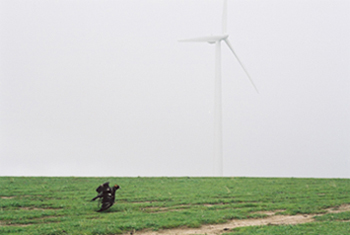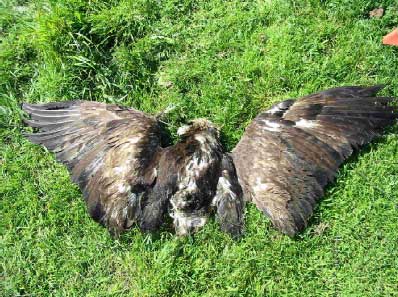| Wind farms: suspicious error by consultant condemns Tasmanian eagle to extinction |
(4382) |
.
STILL IN BUSINESS, THESE “EXPERTS” THREATEN OTHER SPECIES BY USING THE SAME METHOD. |
.

For immediate release
16 June 2010
Save the Eagles International blows the whistle on a firm which provides advice to Australian authorities. Says STEI president Mark Duchamp: “if an engineer certified a bridge for 100 cars but it collapsed the next day under the weight of a single automobile, you would fire him wouldn´t you?” He continues: “if a zoologist reported that a wind farm posed no risk to an endangered species, but a reality check revealed that he found “1” when the reply was “100”, would you still trust him?”
Mr. Duchamp claims he found two errors amounting to that much distortion in a report assessing the risk posed by 7 wind farms to the survival of the Tasmanian Wedge-tailed Eagle. “As a result, the risk was misrepresented and the species is now condemned to rapid extinction”. He pinpoints the errors in an open letter reproduced below.
STEI holds the authors of the report, Biosis Research Pty. Ltd., responsible for this biodiversity disaster. “All over the world, conservationists were disturbed to learn that rare TWT eagles are being killed in significant numbers at the Woolnorth wind farm” says Duchamp, who can’t understand why these consultants are still in business. “They are now assessing a highly sensitive windfarm project in Victoria, but are using the same erroneous parameters that failed in Tasmania. They claim to have corrected them, but this is not true. They even added more distortion.” This manipulation, says STEI, allows them to predict insignificant mortality where in fact 200 to 300 eagles will die.

Above picture: Wedge-tailed Eagle crippled by a wind turbine at Starfish Hill wind farm, South Australia. Turbine blades travel at speeds up to 300 kph at the tip, but appear to move leisurely. This fools the birds.
Australians may have been misled about other species as well, warns Duchamp. On numerous occasions the services of BIOSIS have been used, and negligible mortality has been predicted. He has in mind the cases of the White-bellied Sea Eagle, the Orange-bellied Parrot, the Swift Parrot, and the Brolga, some of them listed as endangered.
STEI concludes: “the fate of Australia’s spectacular bird life should not be left in the hands of “hired guns” consultants in the pay of windfarm interests, public or private.”
Save the Eagles International is a platform constituted by ornithologists and nature conservationists advocating for a realistic assessment of the bird/windfarm problem. Please scroll down to view their open letter exposing the catastrophic error, the misrepresentations and the manipulations.
About STEI´s president:
- Academic Support to Mark Duchamp (2010) --->LINK
- Peer review (2004) of Mark Duchamp´s first significant paper (2003) ---> LINK
- Article in The Telegraph (2010) ---> LINK
- International Symposium on the Red Kite (2009) ---> LINK

Above picture: Golden Eagle mangled to death by a wind turbine blade at Altamont Pass, California.This huge wind farm holds a record: it is estimated to have killed 2,300 golden eagles in 20 years (Dr. Smallwood et al. 2004).
OPEN LETTER FROM STEI TO BIOSIS RESEARCH PTY. LTD.
16 June 2010
Dear Sirs,
Actual eagle mortality at the Woolnorth windfarm has proven that your report, Modelled Cumulative Impacts on the Tasmanian Wedge-tailed Eagle of Wind Farms across the Species’ Range (2005), was wrong by about one order of magnitude (a factor of 10 times). Where you had predicted 1 eagle collision per annum cumulatively for the 7 Tasmanian wind farms, 2 eagles got killed at the Woolnorth wind farm over 2 weeks --->LINK
Then the death toll at Woolnorth increased to 3 dead eagles over a 5-month period: ---> LINK
Interviewed in 2008, the chairman of Birds Tasmania put the actual mortality as high as 18, and more recently raptor expert Dr. Stephen Debus put it at 20: “In practice there have been 12 eagle deaths in two years, and 20 in four years (i.e. an average of 5 per year), at the Woolnorth wind farm alone.” LINK
The other 6 windfarms are not being monitored.
At the Stockyard Hill hearing on 29 March 2010, your senior consultant zoologist Ian Smales recognised the error: “The Wedge-tailed Eagle is a species that appears to exhibit a lower avoidance rate than most bird species (S. Muir, Symbolix Pty. Ltd, unpublished data), which is why the 90% avoidance rate has been provided in Biosis Research collision risk modelling for that species at Woolnorth since 2006” ---> LINK
But in 2005 (when it was important) you used avoidance rates of 95, 98 and 99% in your model, selecting 99% as the rate most likely to be right. This choice resulted in your unrealistic prediction of only one eagle collision per annum for 7 wind farms: “... is likely to result in the additional death of approximately one bird per annum." But reality proved you wrong, with 5 collisions at a single wind farm (yearly average, not counting eagles that may have walked away crippled and any others not registered).
This error was enough to condemn the Tasmanian WT Eagle to extinction. So it was surprising to hear Mr. Smales touting the success of your collision model: “The example of Wedge-tailed Eagles at Woolnorth wind farms demonstrates that the Biosis Research collision risk model is an accurate predictive tool.” (ibid)
It may have been (very roughly) accurate after you adjusted the avoidance rate to 90% in 2006, i.e. after the fact. It wasn’t the case in 2005 when you used 99%, thus erring by about one order of magnitude when the fate of the TWT Eagle was in the balance.
Equally surprising was your Dec. 2009 assessment of the Yaloak South wind farm project for Pacific Hydro: you did not use the corrected avoidance rate of 90% flaunted by Mr. Smales, but the old ones that caused your catastrophic error in 2005. What is more, you introduced a new avoidance rate of 99.8% which yielded an even more unrealistic prediction of 0.4 eagle collisions a year (Chapter 8, page 6). Using the correct avoidance rate of 90% you would have predicted about 10 eagle collisions a year for Yaloak.
You thus repeated in 2009 your deleterious performance of 2005, notwithstanding Mr. Smales claiming that you had corrected your parameters in 2006. This raised our suspicion, so we decided to read in detail your report on the 7 Tasmanian wind farms ---> LINK
The report says the endangered Tasmanian WT Eagle population of 742 birds is “in slow decline” – so why didn’t you warn that your predicted 1 additional death a year would accelerate that decline? It was obvious and it was your duty; and the risk from related power lines was not even assessed, as you noted. But instead, you juggled with survivorship rates until you made another unfortunate mistake, one that condemned the TWT Eagle to extinction: in the Population Viability Analysis model you’ve input “a mortality rate increase of 1.001 over the base scenario”, when it should have been 1.01 - that´s another error of one order of magnitude. Combined with the first one, that’s 2 orders of magnitude (10 x 10 = 100 times smaller than reality).
Demonstration: says your report: "86.60% of the population surviving from one year to the next". Thus, 742 eagles x 86.60% = 642.6 eagles surviving yearly, which means an average of 99.4 deaths per annum. So when you predict that 7 wind farms will kill one eagle a year, that’s a 1% increase. A one per cent increase reads 1.01, not 1.001. QED
But as the actual mortality at 7 windfarms is not 1, but ~10 eagles a year, the input into the PVA model should really have been a 10% increase, which reads 1.1 instead of 1.001. That’s 100 times more than what you did input into the model. If our engineers, architects, physicians, pharmacists, nurses, accountants, etc. were to make errors of one order of magnitude, let alone two, civilisation would collapse.
You found that a mortality increase of 0.5% would have an impact on the viability of the population: “Predicted risk of extinction for Tasmanian Wedge-tailed Eagles of the modelled cumulative impacts of the seven wind farms (i.e. an expected 0.001 increase in mortality) is not significantly different from that indicated for the population in the absence of those wind farms. PVA modelling predicted a significant difference in extinction risk only when the mortality rate increased to five times that level.”
It says the 7 windfarms are unlikely to have an impact on the viability of the population. But even your reality-shy prediction of one dead eagle a year was above (double) the 0.5% increased mortality threshold. Had you input 1% into the PVA model instead of the erroneous 0.1%, the result would have shown a significant extinction risk. This makes you largely responsible for the looming extinction of the rare eagle.
It was otherwise obvious that an endangered population of 742 slow-reproducing birds in slow decline could not sustain one additional death per year (let alone 10 as it turned out to be in real life, plus those from new windfarm-associated power lines * ).
* Power lines: even if the electrocution risk were mitigated by specially designed pylons, death or injury by collision with overhead cables is a major hazard for all birds, especially large ones that can´t manoeuvre easily or depend on updrafts, wind, etc.---> Windfarms - the bird massacre continues.
We conclude this letter with a question: for Yaloak you used avoidance rates that had proved wrong before - 95, 98 and 99%. Mr. Smales himself claimed 90% applies to WT eagles. You even increased your “error” by introducing an avoidance rate of 99.8%. - Why?
Looking forward to your reply,
Sincerely
Mark Duchamp
President, Save the Eagles International
Detailed critique of the Yaloak wind farm project:
Wind farm project likely to kill 200-300 eagles - Australia
and
Save the Eagles International denounces Bird Societies and "hired guns" consultants
Further developments on this case:
Will Australia approve eagle-killer windfarm at Yaloak, rewarding mendacious consultant?
and
Does the Australian government care about biodiversity? - Yaloak is the test.
NOTE: the date below is incorrect, resulting from a malfunction in the webpage programme.
| Insertado
por: Mark Duchamp (12/06/2010) |
| Fuente/Autor:
Save the Eagles International |

Valoración
Comentarios
¿cuántas personas inteligentes, especiales,luchadoras, evolucionadas forman parte de la historia de la humanidad?...Pensando sólo tan pocas que se te pone un nudo en la boca del estómago, tantos millones de carne con dos patas y tan poco cerebro en ellos¡¡¡¡. Mark Duchamp es uno de esas pocas personas que formaran parte de esa historia...
carmen martínez |
| Nombre: carmen martinez (19/06/2010) |
E-mail: karmefarre@msn.com |
| |
| Muchas gracias, Carmen, pero me haces enrojecer. Lo que haces tu para conscienciar a la gente de lo que sufren los animales es invaluable. De no estar metido con lo de los parques eólicos, estaría luchando a tu lado. |
| Nombre: mark duchamp (20/06/2010) |
E-mail: save.the.eagles@gmail.com |
| |
Los mandatarios, que todavía siguen con su afán de construir más parques eólicos ‒aun después de haber sido demostrado su inutilidad (rendimiento entre 2 y 4 %) y su coste exorbitante en materiales para su construcción, su mantenimiento y el peligro y la inconveniencia a que está expuesto su entorno‒ demuestran su incapacidad intelectual para retroceder a sus pasos equivocados.
|
| Nombre: F. Eckenhuijsen Smit (15/02/2011) |
E-mail: eckenhuijsensmit.henneberke@hotm |
| |
|
